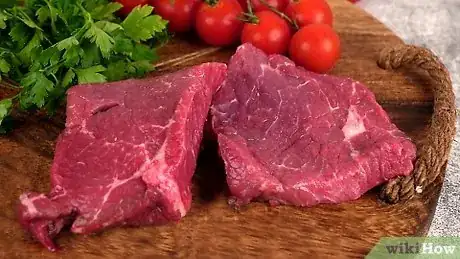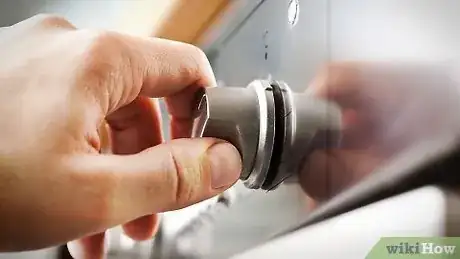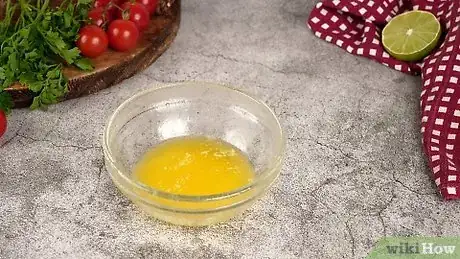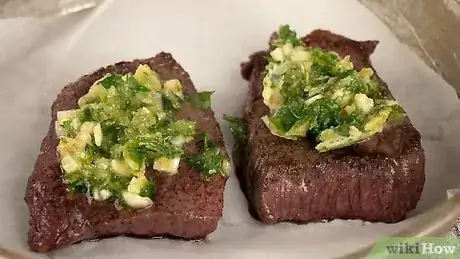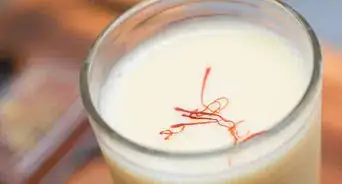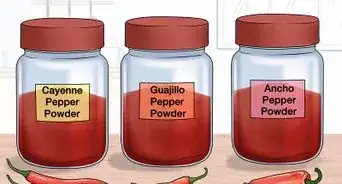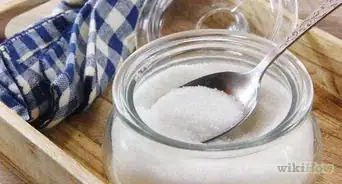This article was co-authored by wikiHow Staff. Our trained team of editors and researchers validate articles for accuracy and comprehensiveness. wikiHow's Content Management Team carefully monitors the work from our editorial staff to ensure that each article is backed by trusted research and meets our high quality standards.
The wikiHow Video Team also followed the article's instructions and verified that they work.
This article has been viewed 33,437 times.
Learn more...
Filet mignon is a flavorful, buttery cut of steak that’s one of the most popular—and expensive—steaks you can buy. The classic, traditional method of seasoning filet mignon uses nothing more than salt and pepper.[1] If you’d like to take a different approach, try seasoning your filet mignon with fresh herbs, garlic, and lemon zest. Or, for a third option, grill the filets after seasoning them with rosemary, pepper, and mustard powder.
Ingredients
- 2 Filet mignon steaks
- 1/8 tsp (0.5 g) of pepper per steak
- 1/8 tsp (0.5 g) of salt per steak
- 1 tablespoon (15 mL) of extra-virgin olive oil
Yields 2 servings
- 2 Filet mignon steaks
- 1 tsp (4 g) of Kosher salt
- 1 tsp (4 g) of pepper
- 1 stick of butter
- 2 garlic cloves
- 1 tbsp (13 g) of chopped parsley
- 1 tbsp (13 g) of chopped thyme
- 1 tsp (4 g) of lemon zest
- 1 tablespoon (15 mL) of olive oil
Yields 2 servings
- 4 filet mignon steaks
- 2 tsp (8 g) of dried peppercorns
- 1/4 tsp (1 g) of dried rosemary
- 1 tsp (3 g) of dried mustard powder
- 3/4 tsp (2 g) of salt
- 1/2 tsp (1.5 g) of garlic powder
- Cooking spray (optional)
Yields 4 servings
Steps
Seasoning with Salt and Pepper
-
1Remove the steak from the fridge 30 minutes before you season it. Set it on the countertop or another location in your kitchen where the steak won’t be disturbed. The half-hour period will let the steak warm up to room temperature, at which point the seasonings will stick to the meat.[2]
- Do not freeze the filet mignon at any point. It should only ever be stored in the fridge.
-
2Pre-heat your oven to 425 °F (218 °C). It will take your oven about 10 minutes to reach this temperature, so turn it on to preheat right before you begin seasoning your steaks.[3]Advertisement
-
3Season the bottom and top of the filet with pepper. Add approximately 1/16 tsp (0.25 g) of pepper on one end of the steak. Then pick the individual filets up, flip them over, and sprinkle about 1/16 tsp (0.25 g) of pepper onto the other side. Season both the top and bottom to taste, but avoid over-seasoning. The pepper should bring out the filet’s natural flavor, not overpower the taste of the meat.[4]
- Don’t put any pepper on the sides of the steak.
-
4Sprinkle salt onto the bottom and top of the steak. Season the steaks with salt just like you did with pepper.[5] Shake roughly 1/16 tsp (0.25 g) of salt onto the top sides of the steaks, then flip them over and shake the same amount of salt onto their bottoms sides. You can apply the pepper and salt at the same time, or apply pepper first and follow up with salt.
- As with the pepper, do not apply any salt to the sides of the filet.
-
5Press the seasonings lightly into the top of the steak with your fingers. Use 3 or 4 fingers to lightly pat the salt and pepper into the top of the steak. This will make the seasonings adhere to the sticky top of the steak and prevent the spices from slipping off when you transport the steak.[6]
- If you press too hard, you’ll flatten the filet.
-
6Heat 1 tablespoon (15 mL) of olive oil in a hot skillet. Heat the skillet over medium-high heat on your stove range until the oil is sizzling hot.[7]
- Cooking the steaks over medium-high heat will result in a cooked, crispy outside and a juicy, flavorful inside.
-
7Drop your steaks in the skillet and let them cook for 4 minutes. Space your steaks out in the skillet so they aren’t touching. Cook them uncovered for 4 minutes. Once the time has passed, use a pair of tongs to flip each of the steaks over.[8]
- Do not move the steaks while they’re cooking. Let them rest, or some of the juices will leak out.
-
8Lift the skillet off the stove and place it in your oven for 5–8 minutes. The amount of time you leave the skillet in the oven depends on how you like your steaks cooked. Leave them in for 5–6 minutes for rare steaks, 6–7 minutes for a medium-rare cook, or 7–8 minutes for medium.[9]
- When lifting the skillet off of the stove, hold it level so the steaks don’t slide around.
-
9Cover the filets with foil on a clean plate for 5–7 minutes. Take the skillet out of your oven, and use a clean spatula to slide the filets off of the pan and onto a clean plate. Fold a 6 in (15 cm) piece of aluminum foil loosely in half, and drape it over the plated steaks. Leave the foil in place for 5–7 minutes. Then, serve the steaks immediately.[10]
- This technique is known as “tenting” the foil. It allows the foil to trap the cooked steaks’ heat without coming directly into contact with the meat.
Flavoring with Fresh Herbs
-
1Chop up fresh basil, fresh thyme, and garlic. You’ll need 1 tbsp (13 g) of chopped parsley, 1 tbsp (13 g) of chopped thyme, and 2 cloves of garlic. Use a sharp kitchen knife to finely dice the herbs and garlic into pieces no larger than 1⁄16 inch (0.16 cm).[11] Once you’ve chopped the herbs up, scrape them into a bowl or leave them on the cutting board.
- If you don’t already have fresh herbs and garlic cloves in your kitchen, purchase them at a nearby grocery store.
-
2Grate 1 tsp (4 g) of fresh lemon zest. Grate the lemon with a lemon-zesting tool, which you can purchase at any kitchen-supply store or supermarket. To grate the zest, press the lemon firmly against the zesting blades and scrape it back and forth.[12] Be careful not to accidentally cut your fingers.
- Set the lemon zest with the chopped herbs and garlic.
-
3Melt 1/2 stick of butter in your microwave. Slice 1 stick of butter in half, and set one piece in a microwave-safe bowl. Place the bowl in the microwave and turn it on for 30 seconds. If the butter hasn’t been melted after this time, continue warming it in 15-second increments until the butter is liquid.[13]
- The butter wrapper should have clearly-marked measurements on the side that will help you find the halfway mark. Half of the stick of butter will measure 4 tbsp (57 g).
-
4Combine the herbs and butter and refrigerate the mixture. Scrape the chopped thyme, parsley, garlic cloves, and lemon zest into the bowl that you melted the butter in. Stir with a spoon until the herbs are evenly distributed. Then, set the bowl in the microwave until the butter and herb mixture hardens.[14] This should take about 4 hours.
- You can periodically test the temperature of the butter by sticking a finger into it.
-
5Pre-heat your oven to 400 °F (204 °C). Although you’ll cook the steaks by pan-searing them in oil and butter, you’ll allow them to finish cooking through in the oven. The oven’s heat will also melt the butter and herb mixture over the steaks.[15]
- Turn on the oven about 15 minutes before you plan to cook the steaks.
-
6Sprinkle 1/2 tsp (2 g) each of salt and pepper onto your steaks. Use Kosher salt for the best results. Sprinkle the seasonings onto tops of each steak and then flip them over and season the bottoms.[16] Be aware that either side can be the top, since the steaks are symmetrical.
- You can use a little more or a little less salt and pepper to suit your personal taste.
-
7Pan-sear the filets using the other ½ stick of butter. Drop the butter into a skillet, and pour in 1 tablespoon (15 mL) of olive oil. Turn the heat up to a high temperature and wait until the butter and oil have melted. Then drop in your steaks. Let the filet mignon cook for 2–3 minutes on each side. Do not slide the steaks around in the pan as they’re cooking.[17]
- While the steaks cook, use a spoon to scoop up butter from the sides of the pan and drizzle it over the steaks.
-
8Set the skillet into the heated oven for 6–8 minutes. Once your steaks have been seared for 4–6 minutes, pick up the skillet and set it directly on a shelf in the 400 °F (204 °C) oven. Shut the door and let the steaks finish cooking in the hot oven.[18]
- The duration of time you leave the steaks in the oven depends on their thickness. Thicker steaks will need a full 8 minutes to finish cooking, while thinner filets will only need 6.
-
9Spoon a dollop of the refrigerated butter mix on top of the steaks. When the filets have only 1 minute left to cook, scoop up a generous amount of the butter and herb mixture that’s been cooling in the fridge. Place 1 dollop of each of the filets, and shut the oven door for the 1 remaining minute.[19]
- The butter will melt into the steak and give it a rich herbal flavor.
-
10Cook the steaks until they’re 135 °F (57 °C) internally. Once the 6-8 minutes have passed, stab a meat thermometer into the center of each steak. If the thermometer displays an inner temperature of 135 °F (57 °C), the steaks are fully cooked. Pull the steaks out from the oven and plate them immediately.[20]
- You can also tell when the steaks are done by pressing down lightly on their tops. A cooked steak will gently depress and then bounce back as you remove your finger.
Cooking with Rosemary and Pepper
-
1Light your charcoal grill. Add enough charcoal to the grill so that it will generate plenty of heat and cook the steaks quickly. You’ll need to add at least 25-30 pieces of charcoal. If you’re concerned that the steaks may stick to your grill, coat the surface with cooking spray.[21]
- It’s fine to use a small squirt of lighter fluid to start the charcoal burning. Avoid using too much fluid, though, or the steaks may have a chemical taste.
-
2Grind up your peppercorns and dried rosemary in a coffee grinder. Place 2 tsp (8 g) of dried peppercorns and 1/4 tsp (1 g) of dried rosemary into a hand-held coffee grinder. Pulse the coffee grinder until the herbs and pepper are ground together into a coarse powder.[22]
- If you don’t already have a coffee grinder, purchase one at a nearby kitchen-supply store.
-
3Combine the pepper mixture and other dry ingredients. Pour the ground pepper and rosemary into a bowl. Add 1 tsp (3 g) of dried mustard powder, 3/4 tsp (2 g) of salt, and 1/2 tsp (1.5 g) of garlic powder. Use a fork to stir the dry ingredients together until they’re fully blended.[23]
- Avoid touching your eyes while mixing the ingredients, since the hot mustard powder could cause them to burn.
-
4Rub the seasoning mix evenly over both sides of your 4 steaks. Use your fingers to scoop up approximately 1/8 of the seasoning mix and rub it across the top of 1 filet mignon steak. Flip the steak over and rub another 1/8 of the mixture onto its bottom side. Repeat this process with all 4 steaks until they’re fully seasoned.[24]
- The steaks should be cold when you’re rubbing the seasoning onto them, not frozen. Never place filet mignon steaks in the freezer.
-
5Cook the steaks on the grill for 3 minutes per side. Drop the steaks onto your hot grill and let them stand for 3 minutes. Don’t slide the steaks while they’re cooking, or you’ll inadvertently squeeze some of the juice out of the meat. Once 3 minutes have passed, flip each of the steaks with a pair of tongs and allow them to cook for another 3 minutes.[25]
- Once the 6 minutes are up, remove the steaks from the grill and serve them immediately.
References
- ↑ https://www.thedailymeal.com/cook/5-best-ways-prepare-filet-mignon
- ↑ https://www.floatingkitchen.net/how-to-cook-the-perfect-filet-mignon/
- ↑ https://www.floatingkitchen.net/how-to-cook-the-perfect-filet-mignon/
- ↑ https://www.floatingkitchen.net/how-to-cook-the-perfect-filet-mignon/
- ↑ https://www.floatingkitchen.net/how-to-cook-the-perfect-filet-mignon/
- ↑ https://www.floatingkitchen.net/how-to-cook-the-perfect-filet-mignon/
- ↑ https://www.floatingkitchen.net/how-to-cook-the-perfect-filet-mignon/
- ↑ https://www.floatingkitchen.net/how-to-cook-the-perfect-filet-mignon/
- ↑ https://www.floatingkitchen.net/how-to-cook-the-perfect-filet-mignon/
- ↑ https://www.floatingkitchen.net/how-to-cook-the-perfect-filet-mignon/
- ↑ https://www.geniuskitchen.com/recipe/restaurant-style-filet-mignon-487364
- ↑ https://www.geniuskitchen.com/recipe/restaurant-style-filet-mignon-487364
- ↑ https://www.geniuskitchen.com/recipe/restaurant-style-filet-mignon-487364
- ↑ https://www.geniuskitchen.com/recipe/restaurant-style-filet-mignon-487364
- ↑ https://www.geniuskitchen.com/recipe/restaurant-style-filet-mignon-487364
- ↑ https://www.geniuskitchen.com/recipe/restaurant-style-filet-mignon-487364
- ↑ https://www.geniuskitchen.com/recipe/restaurant-style-filet-mignon-487364
- ↑ https://www.geniuskitchen.com/recipe/restaurant-style-filet-mignon-487364
- ↑ https://www.geniuskitchen.com/recipe/restaurant-style-filet-mignon-487364
- ↑ https://www.geniuskitchen.com/recipe/restaurant-style-filet-mignon-487364
- ↑ https://www.myrecipes.com/recipe/classic-steak-house-rubbed-filet-mignon
- ↑ https://www.myrecipes.com/recipe/classic-steak-house-rubbed-filet-mignon
- ↑ https://www.myrecipes.com/recipe/classic-steak-house-rubbed-filet-mignon
- ↑ https://www.myrecipes.com/recipe/classic-steak-house-rubbed-filet-mignon
- ↑ https://www.myrecipes.com/recipe/classic-steak-house-rubbed-filet-mignon
- ↑ https://www.floatingkitchen.net/how-to-cook-the-perfect-filet-mignon/
